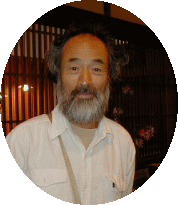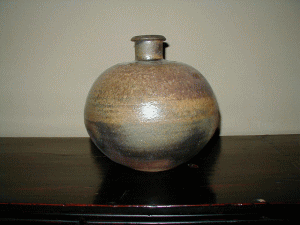Free-Style Pottery from the South
from "nakazato takashi potter's work", published by NHK in 1990
 A Land and House of Tradition
A Land and House of TraditionThis book introduces the personal profile and work of Takashi Nakazato, one of the most celebrated of contemporary Japanese potters. Nakazato creates traditional Japanese ceramics, including crocks and urns not confined to any specific purposes of use as well as plates, bowls, tea utensils, and wine vessels used as dining and drinking utensils in homes and restaurants, moreover, he has been eminently successful in imbuing this pottery with a refreshing modern flavor, striking individuality and new aesthetic freedom.
Takashi Nakazato was born as the fifth son in 1937 in Karatsu, Saga Prefecture, into a family with an extremely long history of participation in creative pottery work. Takashi's father, Taroemon Nakazato, was the twelfth of a long line of master potters in the Nakazato family.
In Japan, the most honored occupations enjoyed special patronage and protection by the feudal lords and shoguns, and when such a trade was passed on from father to child, custom required that the child inheriting the trade assume not only the surname but even the unmodified given name of the father. The Nakazato family were patronized, as distinguished potters, by the successive feudal lords of Karatsu, and therefore the custom of inheriting both the family and given name was observed. At present, the eldest brother of Takashi Nakazato is the thirteenth to bear the given name Taroemon. Reckoning from the time of the first Taroemon, the Nakazato family now boasts an unbroken lineage of master potters extending over a period of some three hundred years.
The Nakazato family is now the most eminent potter family in Karatsu. Moreover, in the regions of Kyushu, Shikoku and Chugoku, the place name Karatsu has actually@become a synonym for pottery. Thus, so ancient is the fame of Karatsu as a ceramics-producing district that the word "karatsumono" now means "pottery" in those regions. Although said to have originated in distant antiquity, the manufacture of pottery in Karatsu attained its first period of flourishing activity during the latter part of the sixteenth century. The pottery produced in Karatsu during the period is known as "old Karatsu". The golden age of Karatsu pottery, which began during the seventeenth century, was marked by the production of a broad spectrum of ceramics, ranging from expensive pottery used in the tea ceremony to everyday eating utensils, and Karatsu developed into the representative pottery-producing district of southwestern Japan. The creative activities of the Nakazato family under the patronage of the local feudal lords also began during the seventeenth century.
By way of explanation, the part "kara" in the place name "Karatsu" originally referred to T'ang Dynasty China, but subsequently came to mean foreign countries generally, including China and Korea as well as the various lands to the south of Japan. The word "tsu" means harbor. Thus, the place name "Karatsu" originally meant a port frequented by foreign ships. Among the foreigners entering Japan via this port, the Koreans had a particularly great influence upon pottery making. Many Korean potters are said to immigrated into the district from the era when the ceramic craft began in Karatsu. This accounts for the marked Korean stylistic flavor of traditional Karatsu pottery. The popularity of Karatsu ceramics products might very well be attributable, at least in part, to the stylistic elements introduced from Korea, which created the impression of imported and therefore attractive products among the Japanese of past ages.
Thus, the birth of Takashi Nakazato in one of Japan's leading pottery-producing districts, with this long history of outstanding ceramic craftsmanship--and, moreover, into the most eminent ceramist family of the district--was one of the major factors determining his career.
Three possible responses might be considered with respect to the bonds imposed by three hundred years of unbroken artistic tradition, i. e., first, orthodox continuation of the tradition, second, complete abandonment of the tradition, and third, progress towards a new form of creation as a reaction to the traditional mode. The work of Takashi Nakazato indicates that he has, in effect, chosen a path closest to the third alternative. Nakazato has not abandoned his inherited tradition, but has created a unique and original world of ceramic craftsmanship known as "Karatsu Nanban", which, by imparting a free and imaginative artistic form to the daily dining utensils of Karatsu pottery, attempts to recapture the vitality which characterized the art prior to its formalization as a fixed tradition. If his intentions had been otherwise, he presumably would not have used the word "Karatsu" in coining the appellation "Karatsu Nanban" for his own work.
What is Karatsu Nanban?
Well, then, just what is the name of the "Karatsu Nanban" created by Takashi Nakazato?
In the sphere of Japanese ceramics, the word "Nanban"refers to the unglazed pottery which is considered as having been introduced into Japan from the southern Asian countries of Indochina, Siam, and the Philippines as well as the southern parts of China and even areas as distant as India. The oldest known Nanban pottery in Japan arrived from abroad during the latter half of the sixteenth century.
According to one theory, this Nanban pottery was actually not manufactured in southern Asian countries but rather in south China, and arrived in Japan indirectly via these various countries. However, the true origin of this pottery still remains uncertain.
Takashi Nakazato travelled an unexpectedly circuitous route which led to the creation of his distinctive Karatsu Nanban, or, perhaps more appropriately, travelled over an unexpectedly vast distance before arriving at this new style of pottery.
In 1971, upon the recommendation of Fujio Koyama, Nakazato relocated in Tanegashima, a small island to the south of Kyushu, and began to work in the indigenous pottery form known as Tanegashima ware (or Yokino ware). Fujio Koyama, himself a potter, is also a distinguished researcher in the field of Chinese and Japanese porcelain, and as acknowledged leader in Japanese ceramic art circles. Nakazato spent three years in Tanegashima, developing his skill in the creative manufacture of Tanegashima ware.
The Karatsu Nanba which Nakazato began to produce after his return to Karatsu in 1974 is composed of the same unglazed pottery which he manufactured in Tanegashima. Indeed, contemplating the powerful, bright style of his unglazed pottery, we can surmise the nature of his work on Yokino ware during his sojourn on that remote island. The so-called Karatsu Nanban of Takashi Nakazato is, perhaps, the quintessence of the fine artistic attributes of the Yokino ware which constituted the focus of his three-year experience in Tanegashima. Incidentally, Tanegashima is known in Japanese history as the island where firearms were first introduced into the land of the rising sun. Thus, Tanegashima is indeed a locality which evokes associations of the so-called "Nanban", that is, the earliest European visitors, who reached Japan from the south. This word is derived from the Sino-Japanese character meaning "south", and pronounced "nan".
Thus, in view of these facts, the Karatsu Nanban pottery of Takashi Nakazato can indeed be regarded as an entity originating in the southern islands. What Nakazato has discovered through the medium of Yokino ware is not merely the characteristic texture of southern style ceramics but also a new perspective for viewing the Karatsu pottery which had previously developed in accordance with an ancient tradition.
Takashi Nakazato and Nature
Even when producing daily dining utensils, Nakazato is not bound by the restrictions of traditional designs, and introduces free, original forms. However, rather than expressing a mere compulsive resistance to tradition, this approach could be more accurately interpreted as liberation of his aesthetic sense, attitudes, and life style from the fixed confines of tradition, and proceeding in accordance with the forms naturally arising from his own free artistic spirit.
Indeed, Nakazato's attitudes toward life reflect his serious efforts toward the goal of self-liberation. He has constructed a home and workshop of his own design in a secluded mountain locality, where he lives and creates pottery along with his family and apprentices. He himself also enjoys cooking, is a devotee of baroque music, and even holds miniature concerts in his workshop.
Superficially, his mode of existence might appear isolated. However, in present day Japan, life in an urban area entails constant exposure to unwanted forms of information and other disturbances. He prefers to lead a natural existence, working assiduously, eating with gust and pleasure, and listening to the music he loves in an environment of pleasant greenery, refreshing wind and the singing of the birds. Takashi Nakazato believes in the value of pottery created as a concomitant of this natural life style.
From the age of about twenty years, Nakazato studied pottery making technique in the workshop of his father, Taroemon, and at the age of twenty-four he was awarded the grand prize in a major ceramics art competition. Although young and talented, he was also circumspect. Subsequently, he spent a period in the United States as a university lecturer, and later travelled in various parts of the world, apparently striving to discover the type work to which he could best dedicate himself and the mode of existence most appropriate for his personal aspirations. As a consequence, he did not choose to continue along the path of an artist devoting efforts toward superficial goals such as prize winning in competitions. Takashi Nakazato is an artist who has staked his destiny upon the pursuit of his own individualistic style of existence and the ceramic creations which naturally emerge from this way of life, regardless of the extent of popular acceptance of this work.

Karatsu Nanban vase by Takashi Nakazato
To the top of this page Information of Ryutagama